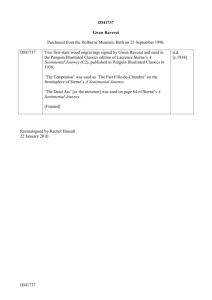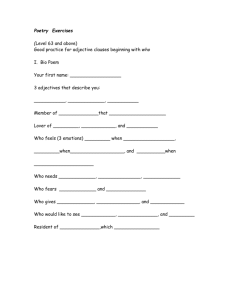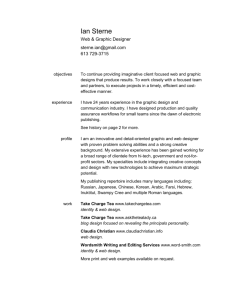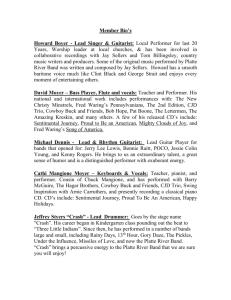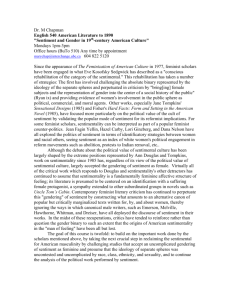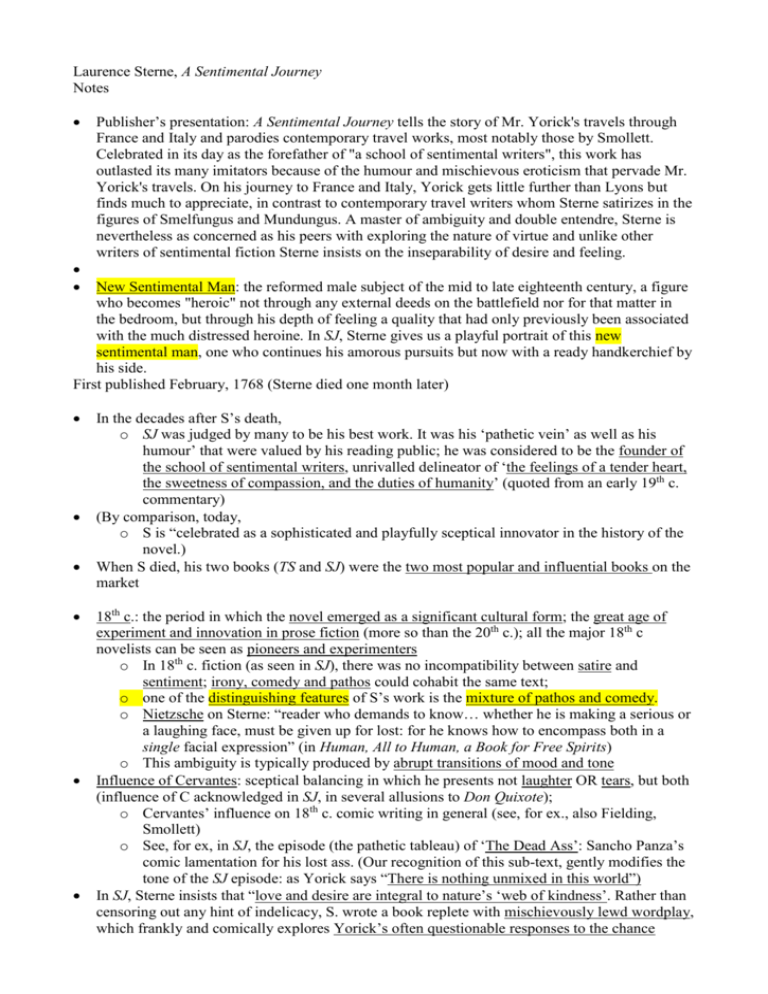
Laurence Sterne, A Sentimental Journey
Notes
Publisher’s presentation: A Sentimental Journey tells the story of Mr. Yorick's travels through
France and Italy and parodies contemporary travel works, most notably those by Smollett.
Celebrated in its day as the forefather of "a school of sentimental writers", this work has
outlasted its many imitators because of the humour and mischievous eroticism that pervade Mr.
Yorick's travels. On his journey to France and Italy, Yorick gets little further than Lyons but
finds much to appreciate, in contrast to contemporary travel writers whom Sterne satirizes in the
figures of Smelfungus and Mundungus. A master of ambiguity and double entendre, Sterne is
nevertheless as concerned as his peers with exploring the nature of virtue and unlike other
writers of sentimental fiction Sterne insists on the inseparability of desire and feeling.
New Sentimental Man: the reformed male subject of the mid to late eighteenth century, a figure
who becomes "heroic" not through any external deeds on the battlefield nor for that matter in
the bedroom, but through his depth of feeling a quality that had only previously been associated
with the much distressed heroine. In SJ, Sterne gives us a playful portrait of this new
sentimental man, one who continues his amorous pursuits but now with a ready handkerchief by
his side.
First published February, 1768 (Sterne died one month later)
In the decades after S’s death,
o SJ was judged by many to be his best work. It was his ‘pathetic vein’ as well as his
humour’ that were valued by his reading public; he was considered to be the founder of
the school of sentimental writers, unrivalled delineator of ‘the feelings of a tender heart,
the sweetness of compassion, and the duties of humanity’ (quoted from an early 19th c.
commentary)
(By comparison, today,
o S is “celebrated as a sophisticated and playfully sceptical innovator in the history of the
novel.)
When S died, his two books (TS and SJ) were the two most popular and influential books on the
market
18th c.: the period in which the novel emerged as a significant cultural form; the great age of
experiment and innovation in prose fiction (more so than the 20th c.); all the major 18th c
novelists can be seen as pioneers and experimenters
o In 18th c. fiction (as seen in SJ), there was no incompatibility between satire and
sentiment; irony, comedy and pathos could cohabit the same text;
o one of the distinguishing features of S’s work is the mixture of pathos and comedy.
o Nietzsche on Sterne: “reader who demands to know… whether he is making a serious or
a laughing face, must be given up for lost: for he knows how to encompass both in a
single facial expression” (in Human, All to Human, a Book for Free Spirits)
o This ambiguity is typically produced by abrupt transitions of mood and tone
Influence of Cervantes: sceptical balancing in which he presents not laughter OR tears, but both
(influence of C acknowledged in SJ, in several allusions to Don Quixote);
o Cervantes’ influence on 18th c. comic writing in general (see, for ex., also Fielding,
Smollett)
o See, for ex, in SJ, the episode (the pathetic tableau) of ‘The Dead Ass’: Sancho Panza’s
comic lamentation for his lost ass. (Our recognition of this sub-text, gently modifies the
tone of the SJ episode: as Yorick says “There is nothing unmixed in this world”)
In SJ, Sterne insists that “love and desire are integral to nature’s ‘web of kindness’. Rather than
censoring out any hint of indelicacy, S. wrote a book replete with mischievously lewd wordplay,
which frankly and comically explores Yorick’s often questionable responses to the chance
encounters with women that his journey throws up.” (OUP intro., xx) (NB: This quote could be
the basis for a discussion question in final evaluation)
Sterne’s “willingness to puncture moments of pathos” are sometimes seen as a way of
parodying sentimental idioms and mocking emotional response per se.
o However, this may not be an accurate interpretation: Sterne upheld the belief that
“human beings are ‘not angels, but men cloathed with bodies’.
o He creates scenes of sympathetic response in which he can demonstrate that compassion
is rarely unmixed with less worthy passions like desire.
S seeks to reconcile feeling and desire; to demonstrate (see the episode of La Fleur and the
letter) that desire is impoverished without feeling, while feeling is equally diminished without a
love that includes desire. For S, the traditional separation of love into 2 kinds, agape (non
sexual) and eros (desire), cannot be strictly maintained.
S’s apostrophe to sensibility:
o “Dear sensibility! Source inexhausted of all that’s precious in our joys, or costly in our
sorrows!... eternal fountain of our feelings! – ‘tis here I trace thee – and this is thy
divinity which stirs within me’ (in the ch. about Maria “The Bourbonnois”)
SJ has been seen as S’s reply to Smollett. See the caricature of Smollett as ‘the learned
Smelfungus’; however, we can also see Smelfungus (like Mundungus), as representing rather a
type of traveller and not that particular traveller.
Relationship between SJ and genre of travel literature:
SJ expresses opinion about travel writing, that it should be about contact with people rather than
an arid documentation of sights seen.
o SJ not really based on Sterne’s personal experiences while travelling on the Continent.
Sterne’s real interest in SJ seems to be in the commonplaces and conventions of travel
writing and not in the kind of detailed accounts of French and Italian culture that form
the focus of genuine travel books like Smollett’s.
Place names that head many of the sections of the novel: seem to promise the reader predictable
descriptions of the monuments and buildings of French towns and cities. Instead, Y offers his
observations on such seeming trifles as the meeting with a mendicant monk, a Parisian barber’s
penchant for hyper bole, or an encounter with a Chevalier de S. Louis selling pâtés.
This focus on the apparently banal is central to Yorick’s contention that ‘non-sensical minutiae
reveals more about Fr culture than the grander reports of traditional travel writers;
This strategy also belongs to the novel’s larger strategy of defamiliarization; of subverting the
readers’ expectations SJ something of an anti-travel book, flouting generic conventions, at the
level of both form and content, in order to disturb the reader’s settled assumptions.
o “Where English travellers typically condemned the idleness and greed of monks or
expressed outrage at the French habit of urinating in public, Y learns lessons from both
Father Lorenzo’s humility and M. de Rambouliet’s candour. More centrally, Y’s
sentimental journey playfully indulges, before finally overturning, the commonplace
association between European travel and sexual adventure. Time and again, S places
Yorick in circumstances that presage erotic liaisons only to have them culminate in
comic anti-climax.
o Sentimental Travel. Travel in search of the picturesque follows certain cultural
preconceptions, fashion and so on, but sentimental travel, is where the traveller records
the 'true impressions' of a place as they strike his refined sensibility. The sentimental
traveller is usually an ironic figure (after Sterne ), but he is supposed to record fine
impressions and atmosphere of a place and the manners of its people. This 'refinement'
of the sentimental traveller, does not come naturally, of course, and implies education,
class and upbringing. At best, sentimental travel is a subjective but cultivated approach
to travel, but at worst, it implies affectation or pretence. In SJ the idea of sentimental
travel is proposed, but S. is almost certainly being ironic. He does show undisguised
scorn for all other kinds of travellers, especially for the earnest and splenetic (irritable,
angry, pessimistic) Smollett, but at the same time, he satirises the affected manners and
habits of the upper classes.
o
One critic on impact of travel literature on early novel: (J. Paul Hunter, Before Novels) suggests
that in fiction the journey ‘is usually … a structure of convenience in which ‘ precise location
is… less important than the fact that there are different locations and that people in different
places actually differ from one another. The menu… of most novels may be human nature, but
there are several courses, and the implication is that no single view of human nature will serve –
that cultures alter people, people alter circumstance, and circumstance alter cases.
o Applied to SJ: S uses Y’s journey as a means of weighing general ‘truths’ about human
benevolence, affection, and desire in the modifying contexts encountered in the
‘expatriated adventurer’
o We can view SJ as a whole as a testing, assaying, of human nature
The structure of the journey serves to provide opportunities to test Y’s emotional
responses and codes of conduct in a variety of unfamiliar situations
SJ regularly stages scenes of temptation in which either Y’s base or nobler
passions – and sometimes both – are revealed.
o Perhaps one explanation for why 18th c readers celebrated SJ in spite of its frank
treatment of Y’s sexual impulses, lies in S’s candid acceptance of conflicted human
nature
Sentimental:
o modern connotations of ‘sentimental’ have little in common with the word’s 18th c.
resonances:
today it tends to imply ‘indulgent emotionalism; such pejorative connotations
began to develop in the late 18th c, in reaction to some of the imitations of S,:
there was a growing sense that essential private manifestations of
sensibility were poor substitutes for active charity and this contributed to
a growing suspicion of the language of feeling. (THIS IS A
TRANSITIONAL CONCEPT IN RELATION TO IDEALS OF
ROMANTICS
o In S’s day, ‘sentimental’ offered among its significations, one deriving from the noun
‘sentiment’, suggesting a moral reflection or opinion. Although such reflections need not
have an emotional colouring, a ‘sentiment’ was often seen to proceed from an alliance of
head and heart.
(See for ex, Adam Smith’s Theory of Moral Sentiments, 1759: focuses on
compassionate sympathy and offers a theoretical analysis of morals understood
to have an emotional basis)
o In this light, the ‘sentimental’ in the title of SJ might be read as an indication that Yorick
‘s narrative is concerned with the reflections or moral sentiments – esp. those relating to
the social virtues of compassion and philanthropy – occasioned by his travels.
o However, S was also exploiting some of the semantic instability of the lexicon of feeling
(at times the term may be referring to its libidinous opposite – the ‘sentimental parts
of…’; it can mean emotionally touching ; it can also signify platonic, non-sexual
affection
o In so far as Y’s erotic adventures are unconsummated (with the possible exception of
that with the Marquesina of F***), his journey is ‘sentimental’ in this non-sexual sense.
o However, Y’s meetings with women are usually risqué enough to bring this purely
chaste signification to the borders of irony.
SJ is a book intent on demonstrating the entanglements of ‘love and desire’ in ‘nature’s web of
kindness’ (Paris episode, The conquest).
o In this light it is appropriate that S’s title should be deliberately ambiguous, hovering
between ‘pure’ feeling and ironic suggestiveness, but settling on neither.
o The ambiguity of the title enacts the novel’s central contention that the distinction
between pure feeling and impure desire can only be sustained in defiance of the complex
fabric of God-given human nature.
S’s effort to deconstruct the binary opposition between sensuality and feeling
Topics for discussion:
Here are a few quotes from studies on SJ that focus on some of its major themes (SJ as
an elaboration of or a comment on the 18th c. concept of sentiment and sentimentalism; SJ as
Sterne’s attempt to reconcile desire and feeling or the head and the heart; SJ as a comment on
the fashion of travel writing; the important contribution of Sterne and SJ to the emerging,
new literary form – the novel). Ultimately you should be able to discuss SJ in relation to
Porter’s chapter 12 “From Good Sense to Sensibility” and to discuss selected episodes in
relation to other literary texts (for ex, the Passport-caged bird episode and Coleridge’s “The
Dungeon” in terms of 18th c. concept of sentimentalism)
The new sentimental man: “the reformed male subject of the mid to late eighteenth century
is a figure who becomes "heroic" not through any external deeds on the battlefield nor for that
matter in the bedroom, but through his depth of feeling. In SJ, Sterne gives us a playful portrait of
the new sentimental man…”
In S’s day, ‘sentimental’ offered among its significations, one deriving from the noun
‘sentiment’, suggesting a moral reflection or opinion. Although such reflections need not have an
emotional colouring, a ‘sentiment’ was often seen to proceed from an alliance of head and heart…
The ‘sentimental’ in the title of SJ might be read as an indication that Yorick ‘s narrative is
concerned with the reflections or moral sentiments – esp. those relating to the social virtues of
compassion and philanthropy – occasioned by his travels.
Unlike other writers of sentimental fiction Sterne insists on the inseparability of desire and
feeling… S seeks to reconcile feeling and desire, to demonstrate (see the episode of La Fleur and
the letter) that desire is impoverished without feeling, while feeling is equally diminished without a
love that includes desire.
Nietzsche on Sterne: “the reader who demands to know… whether Sterne is making a
serious or a laughing face, must be given up for lost: for he knows how to encompass both in a
single facial expression” (in Human, All to Human, a Book for Free Spirits) (one of the
distinguishing features of S’s work is the mixture of pathos and comedy.)
SJ expresses an opinion about travel writing, that it should be about contact with people
rather than an arid documentation of sights seen.
SJ as a whole displays a strategy of defamiliarization, of subverting the readers’
expectations, thus making SJ something of an anti-travel book, flouting generic conventions, at the
level of both form and content, in order to disturb the reader’s settled assumptions.

